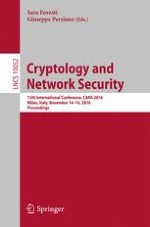2016 | OriginalPaper | Buchkapitel
An Efficient Somewhat Homomorphic Encryption Scheme Based on Factorization
verfasst von : Gérald Gavin
Erschienen in: Cryptology and Network Security
Aktivieren Sie unsere intelligente Suche, um passende Fachinhalte oder Patente zu finden.
Wählen Sie Textabschnitte aus um mit Künstlicher Intelligenz passenden Patente zu finden. powered by
Markieren Sie Textabschnitte, um KI-gestützt weitere passende Inhalte zu finden. powered by
